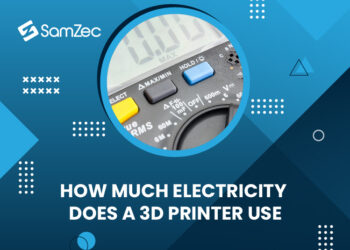As a 3D printer enthusiast, you may need to change the filament on your own instead of sending it to the manufacturer or get professional maintenance services. There are a few pointers that may be useful if you’re new to the game. This article will introduce the three ways to change filament Ender 3D printer.
If you want to use different colors or if your spool of filament runs out, how to change filament ender 3 is a must-know skill.
How to replace the Filament on the Ender 3
Although there is a method known as “cold pull,” which involves yanking the filament out of the nozzle without heating it to unclog it, changing the filament with a cold nozzle is not recommended. Preliminary to replacing the filament, you must first heat the nozzle to the melting/printing temperature of the filament.
To change filament ender 3 rightly, you must first heat the nozzle to the melting/printing temperature of the filament you are applying. Let’s begin by removing the old filament from the machine.
How to unload filament from the Ender 3
- To acquire the menu, switch on the printer and then press the large rotary knob.
- The options are “Control,” “Temperature,” and “Nozzle.
- Set the temperature to that of the filament in the printer (for example, 200°C for PLA, 230°C for PETG, and so on).
- Wait a few minutes after the nozzle reaches the desired temperature to ensure that the filament is properly melted.
- With one hand, press down on the Idler’s arm, and the other, pull the filament out.
That’s all there is to it! Always preheat the nozzle to the correct temperature before attempting to remove it. To keep the filament from tangling, feed it through the small holes in the spool.
How to load new filament on the Ender 3
Maintain the nozzle warm through the filament loading process because it will make things easier and faster.
- The nozzle should be heated to the new filament’s printing temperature.
- Replace the spool holder with the new filament spool.
- Push it all the way to the nozzle at the end of the tube (you can usually hear it sizzle once it gets to the nozzle).
Insert the filament through the small hole on the extruder, which will guide it between the extruder gear and the idler wheel into the PTFE tube, with one hand pressing down on the idler arm and the other inserting the filament through the small hole on the extruder, which will guide it between the extruder gear and the idler wheel.
- Continue to push it down the tube until it reaches the nozzle (you can usually hear it sizzle once it gets to the nozzle).
The new filament is now loaded and almost ready to use; however, the old filament must be completely removed from the nozzle.
How to eliminate the old filament from the nozzle and have it ready for printing
What is the best way to get the old filament out of the nozzle so that I can print with it? If you only followed the first two steps before printing, you may have noticed that the old filament extrudes first, which you don’t want because it could contaminate your new filament.
Fortunately, all you have to do is extrude some filament until the new one emerges, leaving no traces of the old one.
There are two methods for doing so: using the printer’s firmware to extrude the plastic, or manually pushing the filament into the nozzle. This is the best way to replace or how to change filament Ender 3.
How to Extrude the old filament via firmware
- Heat the nozzle to the temperature of the newly loaded filament for printing.
- Go to the menu and select “Prepare,” “Move Axis,” “Extruder,” and the 10mm option.
In the “Move Axis” Menu go to “Extruder”.
- Check if the new filament is coming out after extruding 20mm-30mm of plastic (easy to tell when using a different colored filament).
- Rep this process until no traces of the old filament remain.
Although this is a very effective and quick method, I don’t use it because it takes a little longer than doing it manually.
How to Extrude the old filament manually
- Heat the nozzle to the temperature of the newly loaded filament for printing.
- Push down on the idler arm until the filament is no longer stopped by the extruder gear and manually push it down the PTFE tube and into the nozzle once the nozzle is properly heated.
- Another option is to manually turn the extruder to feed filament into the nozzle using an Extruder Knob (free print).
Do you need to re-level the bed after changing the filament?
After swapping out the filament, especially if it’s the same type of filament, such as PLA, it’s usually not necessary to level the bed. Other types of filaments, on the other hand, may require different nozzle and bed temperatures, necessitating a re-leveling of the bed due to temperature variations that can cause the bed to expand or contract.
As long as the new filament I’m loading uses the same bed temperatures, I usually don’t need to re-level the bed. PLA and TPU, for example.
However, if I was printing with PETG and now load a spool of PLA, I will need to re-level the bed because PETG requires an ideal bed temperature of 85°C for better adhesion while PLA only requires 60°C.
Can you pause a 3D print to change filament?
To change filament Ender 3 in the middle of a printer, pause the print, which will stop the print, and move the nozzle to the side, allowing you to change the filament and purge the one that is still inside the nozzle. Continue printing after this, and the printer will pick up where it left off.
When you do this, the Ender 3 purges some of the filament, but I recommend going to “Prepare,” then “Move Axis,” then “Extruder,” select the 10mm option, and extrude enough plastic until only the new filament comes out cleanly.
Conclusion
How to change filament ender 3 is not complicated, it requires a little attention to detail. The first thing you have to do is open the top cover. Once you have access to the top of the machine, you have to remove the power supply, control panel, and the ender 3 controllers to gain access to the extruder. Once you have access to the extruder you can remove the filament. To replace the filament, you have to first remove the ender 3 motors, then replace the filament, then reconnect the motor, then place the ender 3 motors, then place the control panel, then replace the power supply.




















